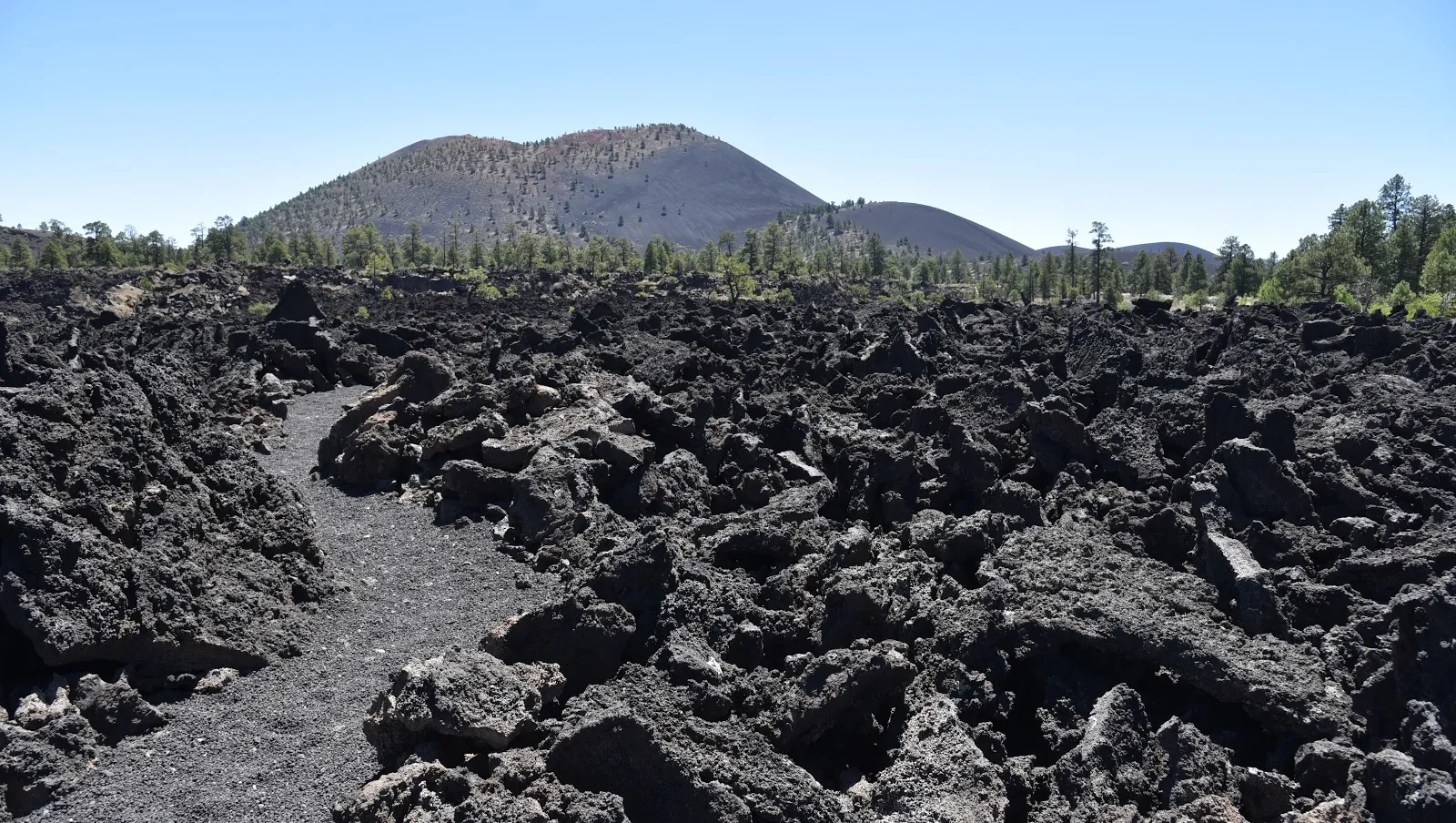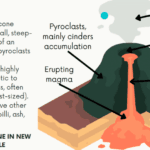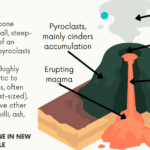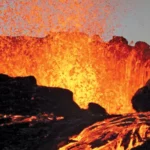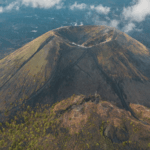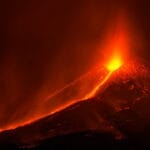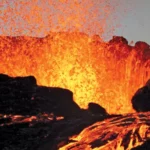Step into a world forged by fire and ice as we explore the captivating volcanic history of Flagstaff, Arizona. This is a tale of powerful eruptions, flowing lava, and the awe-inspiring forces that have sculpted this remarkable landscape over millions of years. We’ll delve into the mechanics of volcanoes, the potential risks they pose, and the fascinating geological wonders they leave behind. Get ready for a fiery adventure through time!
Flagstaff Volcano: A Journey Through Time
Imagine standing in the heart of Northern Arizona, surrounded by the stark beauty of the San Francisco Volcanic Field. Time seems to stand still here, where the Earth’s fiery past is etched into the landscape, leaving behind majestic volcanoes and cinder cones. Among these silent giants, Flagstaff Volcano beckons, inviting you to uncover its secrets.
Flagstaff Volcano is not your typical cone-shaped volcano. Geologists classify it as a stratovolcano, a mountain built up over countless eruptions, its layers composed of lava, ash, and rock. This gives Flagstaff Volcano a rugged, imposing presence, rising to an impressive height of 3,850 meters – that’s taller than 12 Empire State Buildings stacked on top of each other!
But Flagstaff Volcano doesn’t stand alone in this volcanic playground. It shares its domain with a cast of fascinating characters, each with its own story to tell. One such character is Sunset Crater Volcano, a relatively young cinder cone that erupted about 900 years ago. Its well-preserved crater and lava flows offer scientists a glimpse into the fiery processes that have shaped this region. And these processes have been incredibly active! The San Francisco Volcanic Field has been alive for a staggering 3 million years, continuously molding the landscape.
The story of Flagstaff Volcano is not just about fiery eruptions; it’s about the constant interplay between creation and destruction, a dance between volcanic activity and erosion. Over eons, wind, water, and ice have sculpted the volcano’s slopes, carving out valleys, canyons, and unique geological formations. It’s a game of geological rock-paper-scissors, played out over millennia, with each force leaving its mark. These formations are more than just visually stunning; they are open books, revealing secrets of our planet’s dynamic past and providing scientists with invaluable clues about the inner workings of the Earth.
The San Francisco Volcanic Field, with Flagstaff Volcano at its heart, is more than just a collection of geological formations; it’s a testament to the raw power of nature, a place of wonder and inspiration. It reminds us that our planet is a living, evolving entity, constantly changing and reshaping itself. So, the next time you find yourself in Northern Arizona, take the time to explore this volcanic wonderland. Let your imagination run wild as you envision the fiery eruptions, the slow creep of glaciers, and the relentless forces that have crafted this incredible landscape. You’ll come away with a profound appreciation for the power of nature and the stories etched into every rock, valley, and peak.
Does Flagstaff have a volcano?
Absolutely! Flagstaff sits right in the middle of the San Francisco Volcanic Field, a vast area covering a significant portion of northern Arizona. This isn’t just a casual term – the San Francisco Volcanic Field boasts over 600 volcanoes!
To put it into perspective, the ground beneath Flagstaff has been bubbling and bursting with volcanic activity for millions of years. This area began taking shape approximately 3 million years ago with the formation of Bill Williams Mountain, a volcanic peak that announced its arrival with a (volcanic) bang.
The reason for this abundance of volcanoes lies in something called the Rio Grande Rift. Picture a giant crack in the Earth’s crust, stretching all the way from Colorado to Mexico. That’s the Rio Grande Rift, and it’s been slowly pulling apart for millions of years. This pulling and stretching weakens the Earth’s crust, allowing molten rock (magma) to squeeze up to the surface and create volcanoes.
But don’t worry, a sudden lava flow isn’t likely to interrupt your stroll through downtown Flagstaff. The most recent eruption in the area occurred about 950 years ago at Sunset Crater. While that might sound like a long time ago, geologically speaking, it’s just a blink of an eye!
While there’s no immediate danger, scientists continue to monitor the area closely, knowing the unpredictable nature of volcanoes. The San Francisco Volcanic Field serves as a giant outdoor laboratory for scientists, offering a unique opportunity to study how volcanoes erupt, how the landscape changes over time, and even what our planet might have looked like millions of years ago.
So, next time you’re in Flagstaff, take a moment to contemplate the fiery history beneath your feet. Those seemingly peaceful mountains and craters serve as a reminder that Earth is a dynamic and ever-changing planet.
When was the last time the volcano in Flagstaff erupted?
Given all the volcanic features around Flagstaff, it’s natural to wonder when the last eruption occurred. The answer might be a bit underwhelming if you’re picturing a catastrophic, Hollywood-style eruption. The last eruption near Flagstaff was more of a slow burn, taking place at Sunset Crater nearly a thousand years ago – sometime between 1064 and 1065 AD. While this might seem like ancient history, geologically speaking, it’s quite recent.
Sunset Crater’s eruption, while not a sudden, explosive event, was still a powerful display of nature’s forces. It spewed out enough ash and lava to create the impressive 340-meter-high cone we see today.
However, it’s crucial to remember that Sunset Crater is not an isolated incident. It’s part of a much bigger picture. The entire area around Flagstaff, known as the San Francisco Volcanic Field, is dotted with the remnants of hundreds of volcanoes. Over millions of years, this region has witnessed over 600 eruptions.
And the story isn’t over yet. This entire area sits atop what geologists call a “hotspot,” a place where molten rock from deep within the Earth is constantly welling up. This means there’s always a chance of another eruption somewhere in the San Francisco Volcanic Field.
Predicting precisely when or where the next eruption might occur is impossible. It’s similar to predicting earthquakes – we know they’re coming; we just don’t know exactly when or where. Scientists are constantly monitoring the area, using sophisticated equipment to detect any signs of potential eruptions.
So, while you don’t need to fear an impending volcanic apocalypse in Flagstaff, it’s fascinating to consider that you’re standing on a massive, slumbering volcano field. Who knows, maybe someday in the distant future, we’ll get to witness the birth of a brand-new volcano right here in Arizona!
Are there any active volcanoes in AZ?
We’ve discussed volcanoes in general, but what about Arizona specifically? Does the Grand Canyon State have any active volcanoes lurking beneath its surface? The answer might surprise you. Arizona actually has a fiery past, with seven young volcanic fields. And while most of these haven’t erupted for a very long time, three still capture the attention of geologists – because they are considered active. This means there’s still a chance these dormant giants could awaken one day.
The most well-known is the San Francisco Volcanic Field, stretching over a massive 3,000 square miles – larger than some states! This field, located in northern Arizona, boasts a staggering number of volcanoes – over 600! It’s a geologist’s dream, a testament to millions of years of volcanic activity, shaping the landscape with rivers of molten rock and showering the land with volcanic ash.
But that’s not all! Arizona also has the Uinkaret Volcanic Field, perched on the North Rim of the Grand Canyon, and the Pinacate Volcanic Field, standing sentinel on the Arizona-Mexico border. Both are considered active, adding to the intrigue of Arizona’s volcanic legacy.
However, just because scientists classify these fields as “active” doesn’t mean you need to start preparing for a volcanic evacuation. “Active” simply means there’s a chance of future eruptions – it could happen tomorrow, thousands of years from now, or not at all! Geologists remain vigilant, constantly monitoring these areas for any signs of activity.
Does Northern Arizona Have Volcanoes?
Northern Arizona isn’t just about breathtaking red rocks and canyons; it has a hidden wild side – volcanoes! Imagine a region where, millions of years ago, the earth roared to life, and fiery molten rock burst through the surface, shaping the dramatic landscape we see today. This is the legacy of the San Francisco Volcanic Field, a massive area spanning across northern Arizona. And we’re not talking about just a handful of volcanoes. Picture over 600 volcanic mounds and mountains scattered across the landscape – a testament to an incredibly active volcanic past.
These aren’t your picture-perfect, cone-shaped volcanoes either. They come in all shapes and sizes, from towering cinder cones to vast lava flows that resemble frozen rivers of fire.
One of the most fascinating sites in this volcanic wonderland is Sunset Crater. This relatively young volcano erupted just over 950 years ago, which is remarkably recent in geological terms. Imagine – Native Americans living in the area witnessed this eruption! Today, Sunset Crater National Monument protects this incredible site, allowing visitors to walk through lava flows, see the remnants of the eruption, and imagine the sheer power that shaped this land.
So, if you’re ever near Flagstaff, Arizona, a detour to the San Francisco Volcanic Field is a must. It’s a chance to step back in time and witness the awesome power of nature that created this unique and captivating landscape.
How long is the lava tube in Flagstaff?
Near Flagstaff, you’ll find Lava River Cave, an impressive testament to the power of molten rock. This cave was formed approximately 700,000 years ago when a river of lava carved a tunnel through the earth. The tunnel it left behind stretches for about three-quarters of a mile – a significant underground journey!
Descending into Lava River Cave is an adventure in itself. Prepare to navigate loose gravel, large boulders, and dirt as you climb down about 300 feet. It’s like stepping back in time, experiencing the raw power of nature. For outdoor enthusiasts seeking a truly unique experience, Lava River Cave should be on your bucket list. Plus, it’s conveniently located just a quick 30-45 minute drive from Flagstaff, making for an easy and unforgettable day trip.
Does Sedona Have a Volcano?
While you won’t find an active volcano rumbling in the heart of Sedona, the town’s famous red rocks whisper of ancient volcanic activity. These rocks are remnants of eruptions that occurred long ago, shaping the landscape we see today.
For a more up-close and personal volcanic adventure, take a short drive from Sedona to Flagstaff. There, you’ll encounter the San Francisco Volcanic Field, a vast area dotted with extinct volcanoes, offering a glimpse into the Earth’s fiery past.
One of the most captivating spots in the volcanic field is Sunset Crater Volcano National Monument. The monument protects a relatively young volcano, which last erupted about 900 years ago. Visitors can still witness the cinder cones and lava flows, frozen in time.
For those feeling extra adventurous, Lava River Cave, a lava tube formed by molten rock, offers a unique opportunity for exploration. Imagine walking in the path where lava once flowed!
Here’s a quick recap:
- Sedona: No volcano within the city limits, but the famous red rocks hint at ancient volcanic activity.
- Flagstaff (nearby): Home to the San Francisco Volcanic Field, a haven for volcano enthusiasts.
- Sunset Crater Volcano National Monument: Offers a close-up view of a relatively young volcano.
- Lava River Cave: Provides a unique opportunity to explore an actual lava tube.
The entire Flagstaff area serves as a reminder that the earth is in a constant state of change. It’s humbling to contemplate the forces that have sculpted the landscape we see today!
Do earthquakes happen in Flagstaff?
While we’ve focused on volcanoes, it’s also important to consider earthquakes. You might be surprised to learn that Flagstaff does experience its fair share of earth-shaking events. While the volcanoes around Flagstaff are primarily dormant, the ground beneath the surface is far from still.
To understand why, imagine the Earth’s surface as a giant jigsaw puzzle. The puzzle pieces, called tectonic plates, are constantly shifting and grinding against each other. These movements can cause the ground to shake, resulting in earthquakes.
Flagstaff might not be located on the San Andreas Fault, but it sits within a region where tectonic plates are still jostling for position. This means earthquakes, while generally not as powerful as those experienced in other parts of the world, are a normal occurrence in Flagstaff.
Experts believe that moderate-sized earthquakes, strong enough to rattle dishes but unlikely to cause significant damage, occur in the Flagstaff area every 5-10 years. Fortunately, the Arizona Broadband Seismic Network continuously monitors the ground for any unusual activity, providing valuable data and early warnings.
While the chances of a major earthquake hitting Flagstaff are relatively low, it’s always wise to be prepared. Knowing what to do during an earthquake can make a significant difference.
Is Snowbowl an Active Volcano?
Snowbowl, the popular ski resort, sits on the slopes of Mount Humphreys, a once mighty volcano within the San Francisco Volcanic Field. While it might seem like a recipe for disaster, rest assured, Mount Humphreys hasn’t erupted for a very, very long time – over 100,000 years! This classifies it as “dormant,” meaning it’s essentially taking a very long nap.
However, while Mount Humphreys might be slumbering, the San Francisco Volcanic Field itself is still considered active. This means that while one volcanic vent might be quiet, another could potentially awaken. Scientists closely monitor the area because even though a major eruption in the near future is unlikely, it’s essential to be aware of the possibility.
Here’s a quick summary:
- Snowbowl itself?: Not active; more like a sleeping giant.
- The larger volcanic field?: Still considered active, with the potential for future eruptions.
- Should you be worried?: Not at this time, but it’s always good to stay informed about the land we live and play on.
It’s fascinating to imagine that hundreds of thousands of years ago, this area pulsed with volcanic activity. And while those days are long gone, it’s a reminder that our planet is a dynamic and ever-changing place.
How hot is Flagstaff lava Cave?
Venturing into Flagstaff’s Lava River Cave is like stepping back in time, exploring a tunnel carved by fiery molten rock some 700,000 years ago. As you navigate the cave’s twists and turns, picture yourself walking where that river of lava once flowed. It’s a trek of about 0.75 miles, with loose gravel underfoot and some pretty impressive boulders to maneuver around.
You might be surprised to learn that the temperature inside Lava River Cave remains a consistent 35° to 45° Fahrenheit year-round. That means no matter how hot it gets outside, the cave offers a refreshingly cool escape.
Scientists believe this consistent temperature is due to something called geothermal heat exchange. Essentially, the Earth’s interior helps regulate the cave’s temperature, creating a natural underground sanctuary.
Here’s what you need to know about Lava River Cave:
- Temperature: A comfortable 35° to 45° Fahrenheit year-round.
- Length: Approximately 0.75 miles of explorable passages.
- Accessibility: Open to the public year-round.
- What you’ll see: Amazing geological formations, from spacious caverns to narrow passages, all shaped by volcanic activity.
Want to learn more? Visit the Coconino National Forest website for more information about Lava River Cave.
Is there a volcano at the Grand Canyon?
The Grand Canyon is undoubtedly a natural wonder, but you might not realize that volcanoes have played a significant role in its story. While bubbling lava might not be the first thing that comes to mind when picturing the Grand Canyon, volcanic eruptions have been shaking things up in the region for ages.
One of the most compelling pieces of evidence is Sunset Crater Volcano, formed by a relatively recent eruption (geologically speaking) around 1,064 years ago. Sunset Crater, a cinder cone volcano located near Flagstaff, Arizona, is incredibly well-preserved, offering a glimpse into the powerful volcanic forces that shaped the Grand Canyon region.
If you’re planning a trip to the Grand Canyon, a visit to Sunset Crater Volcano National Monument is highly recommended. Here, you can witness this unique landscape firsthand, embarking on a scenic drive, hiking along trails, or visiting the visitor center to delve into the geology of the area.
The volcanic activity that shaped both the Grand Canyon and Sunset Crater is more than just a cool fact; it’s a powerful reminder that our planet is in a constant state of flux. What we see at the Grand Canyon today is merely one chapter in a story that’s still being written.
Want to learn more?
Check out the Sunset Crater Volcano National Monument website: https://www.nps.gov/sucr/index.htm.
Did you know there are numerous fascinating facts about Cinder Cone Volcanoes? They possess a distinctive appearance and form through explosive eruptions. To learn more about these captivating geological structures, follow this link. Additionally, if you’re curious about Arizona’s volcanic activity, don’t miss this article revealing intriguing details about the state’s active volcanoes.
- China II Review: Delicious Food & Speedy Service - April 17, 2025
- Understand Virginia’s Flag: History & Debate - April 17, 2025
- Explore Long Island’s Map: Unique Regions & Insights - April 17, 2025
